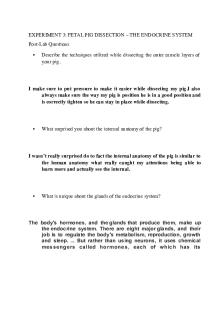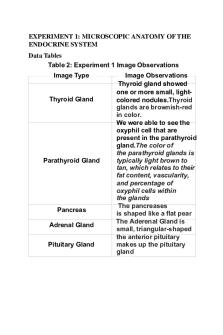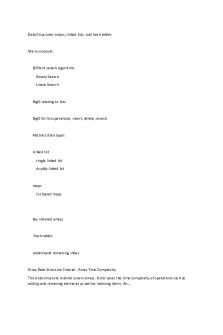Experiment 3 Data Tables and Assessment PDF

| Title | Experiment 3 Data Tables and Assessment |
|---|---|
| Author | ania ojeda |
| Course | Professional Nursing I |
| Institution | Florida International University |
| Pages | 3 |
| File Size | 90.3 KB |
| File Type | |
| Total Downloads | 22 |
| Total Views | 133 |
Summary
helpful for nursing school...
Description
EXPERIMENT 3: BLOOD PRESSURE Data Tables Table 2: Blood Pressure and Pulse Readings Activity Basal (Normal) Lying Down After Exercise
Blood Pressure (Systolic/ Pulse (beats/ Diastolic; minute) mmHg) 150/100 84 130/90 76 160/100 68
Post-Lab Questions •
What is systolic pressure? Diastolic pressure?
Systolic blood pressure (the first number) – indicates how much pressure your blood is exerting against your artery walls when the heart beats. Diastolic blood pressure (the second number) – indicates how much pressure your blood is exerting against your artery walls while the heart is resting between beats.
•
Why is pressure a sensible reading to measure circulatory
health?
Pressure is a sensible reading to measure circulatory health because it is the force that the blood applies in the walls of the veins and arteries and will not be sensible to have someone go for an operation just to measure the blood. The blood pressure measures the efficiency of the heart in terms of blood pumped per minute.
•
Explain the “lub-dub” sounds of the heartbeat.
The “ lub” is the first heart sound, commonly termed S1, and is caused by turbulence caused by the closure of mitral and tricuspid valves at the start of systole. The second sound,” dub” or S2, is caused by the closure of aortic and pulmonic valves, marking the end of systole. •
Who do blood pressure and heart rate change after exercise?
Your heart starts to pump harder and faster to circulate blood to deliver oxygen to your muscles. As a result, systolic blood pressure rises. It's normal for systolic blood pressure to rise to between 160 and 220
mm Hg during exercise. •
How might the results in Table 2 change if someone else performed the activities? Why?
The results might change if someone else does it because everybody is different and might react to it in a different way.
•
Why is it important for blood to flow in only one direction?
It is important for blood to flow only in one direction since blood cannot flow backwards and thus avoid mixing of oxygenated and deoxygenated blood in the heart chambers. ... The blood flows in one direction due to pressure. The veins consist of valves, which prevent the blood from move backwards....
Similar Free PDFs

Chem111 Experiment 3 Data
- 3 Pages

Tables (Design Data) 313
- 58 Pages

Experiment 7 Data Observations
- 4 Pages

homework 3 - truth tables
- 6 Pages

Wills and Administration Tables
- 3 Pages

Truth Tables and Tautology
- 3 Pages

Formula sheet and tables
- 101 Pages
Popular Institutions
- Tinajero National High School - Annex
- Politeknik Caltex Riau
- Yokohama City University
- SGT University
- University of Al-Qadisiyah
- Divine Word College of Vigan
- Techniek College Rotterdam
- Universidade de Santiago
- Universiti Teknologi MARA Cawangan Johor Kampus Pasir Gudang
- Poltekkes Kemenkes Yogyakarta
- Baguio City National High School
- Colegio san marcos
- preparatoria uno
- Centro de Bachillerato Tecnológico Industrial y de Servicios No. 107
- Dalian Maritime University
- Quang Trung Secondary School
- Colegio Tecnológico en Informática
- Corporación Regional de Educación Superior
- Grupo CEDVA
- Dar Al Uloom University
- Centro de Estudios Preuniversitarios de la Universidad Nacional de Ingeniería
- 上智大学
- Aakash International School, Nuna Majara
- San Felipe Neri Catholic School
- Kang Chiao International School - New Taipei City
- Misamis Occidental National High School
- Institución Educativa Escuela Normal Juan Ladrilleros
- Kolehiyo ng Pantukan
- Batanes State College
- Instituto Continental
- Sekolah Menengah Kejuruan Kesehatan Kaltara (Tarakan)
- Colegio de La Inmaculada Concepcion - Cebu








